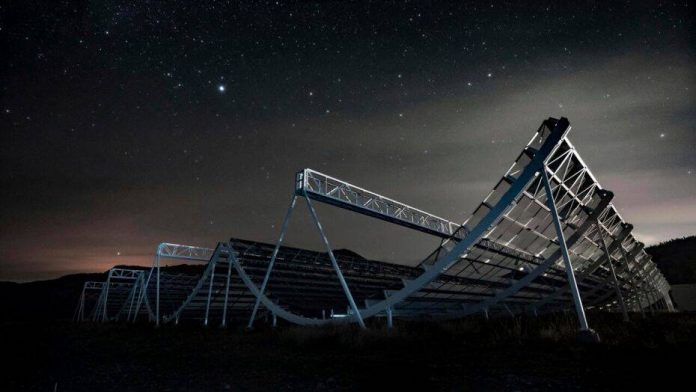Astronomers have traced mysterious, intense blasts of radio energy coming from within our own galaxy.
On 28 April 2020, a team of approximately 50 students, postdocs and professors from the Canadian Hydrogen Intensity Mapping Experiment (CHIME) Fast Radio Burst Collaboration detected an unusually intense radio burst emanating from a nearby magnetar located in the Milky Way. In a study published today in Nature, they show that the intensity of the radio burst was three thousand times greater than that of any magnetar measured thus far, lending weight to the theory that magnetars are at the origin of at least some FRBs.
“We calculated that such an intense burst coming from another galaxy would be indistinguishable from some fast radio bursts, so this really gives weight to the theory suggesting that magnetars could be behind at least some FRBs,” said Pragya Chawla, one of the co-authors on the study and a senior PhD student in the Physics Department at McGill.
FRBs were first discovered over a decade ago. Originally thought to be singular events, astronomers have since discovered that some of these high-intensity blasts of radio emissions – more intense than the energy generated by the Sun over millions to billions of years – in fact repeat.
One theory hypothesized FRBs to be extragalactic magnetars – young extremely magnetic neutron stars that occasionally flare to release enormous amounts of energy.
“So far, all of the FRBs that telescopes like CHIME have picked up were in other galaxies, which makes them quite hard to study in great detail,” said Ziggy Pleunis, a senior PhD student in McGill’s Physics department and one of the co-authors of the new study. “Moreover, the magnetar theory was not supported by observations of magnetars in our own galaxy as they were found to be far less intense than the energy released by extragalactic FRBs until now.”
Magnetar origin for all FRBs remains to be confirmed
“However, given the large gaps in energetics and activity between the brightest and most active FRB sources and what is observed for magnetars, perhaps younger, more energetic and active magnetars are needed to explain all FRB observations,” added Dr. Paul Scholz from the Dunlap Institute of Astronomy and Astrophysics at the University of Toronto.
Smoking-gun proof of a magnetar origin for some FRBs would come from the simultaneous detection of an extragalactic radio burst and an X-ray burst. However, this will likely only be possible for nearby FRBs. Fortunately, CHIME/FRB is discovering these in good numbers.















